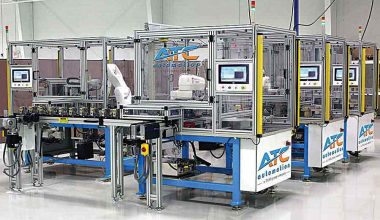Manufacturers rely on logistics while monitoring complicated processes to preserve efficiency, decrease costs, and meet the needs of their customers. Because of the prevalence of e-commerce enterprises such as Amazon, logistics encompasses more than just the moving of goods from one location to another.
What is Logistics?
In general, logistics is the careful planning and execution of a complex task. Logistics, in a broad business sense, is the management of the flow of goods between the point of origin and the site of consumption in order to satisfy the needs of customers or companies.
Physical commodities such as food, materials, animals, equipment, and liquids, as well as intangible items such as time and information, can all be included in the logistics resource management process. Physical item logistics often entails the integration of information flow, materials handling, production, packaging, inventory, shipping, warehousing, and, in some cases, security.
In order to meet the needs of the client, logistics management is the branch of supply chain management that plans, implements, and controls the efficient, effective forward and reverse flow and storage of goods, services, and related information. Dedicated simulation software can be used to simulate, evaluate, visualize, and optimize the complexity of logistics. The reduction of resource utilization is a common motivation in all logistics disciplines. A logistician is a professional who works in the field of logistics management.
Components of Logistics
The following business functions may be included in logistics management:
- Inbound transportation
- Outbound transportation
- Fleet management
- Warehousing
- Materials handling
- Order fulfillment
- Inventory management
- Demand planning
Why is Logistics Important?
Although many small businesses focus on the design and manufacture of their products and services to best fulfill client needs, the business will fail if those products cannot reach customers. It is the primary function of logistics.
But, logistics has an impact on other elements of the business as well.
The more efficiently raw resources are purchased, delivered, and stored until they are utilized, the more profitable the business will be. A company can be made or broken by coordinating resources to ensure the timely supply and usage of materials.
On the customer side, if products are not created and transported on time, customer satisfaction may suffer, affecting a company’s profitability and long-term viability.
Processes of Logistics
Logistics can be classified into three types:
#1. Inbound Logistics
Inbound logistics refers to the process of transporting raw materials or components from suppliers to manufacturers. It will frequently include automated ordering and fulfillment to ensure that producers always have the supplies needed to generate new goods. The raw material and component lists are extensive, but the goal is the same: to supply manufacturers, distributors, and retailers with the items they require to keep products flowing through the supply chain to customers and end users.
#2. Outbound Logistics
The movement of completed or finished products and other goods to the next level of the supply chain is referred to as outbound logistics. Moving products from manufacturers to warehouses, fulfillment centers, or distribution centers, as well as shipping them to customers, merchants, or other end destinations, could be included. Inefficient incoming logistics management produces a chain reaction inside an organization’s outbound logistics procedures, eventually disrupting the entire supply chain.
#3 Reverse Logistics
Reverse logistics is the process of returning goods from customers and end users back through the supply chain to fulfillment centers, distribution centers, merchants, and producers. This might happen when a product is damaged or defective, needs repairs or refurbishment, or has reached the end of its useful life and requires special or specialized disposal processes. The reverse logistics process begins at the time of sale and continues until the product is disposed of.
Logistics Vs Reverse Logistics
If not optimized for improved performance and efficiency, both logistics and reverse logistics can have a substantial impact on your supply chain. Providing products and other commodities to clients swiftly and affordably is critical to their happiness, but so is processing and managing returns that must be returned via your supply chain in the reverse direction. Inventory management, supply planning, demand planning, and other fundamental supply chain activities all work together to produce an efficient supply chain, as do logistics and reverse logistics, and these systems must all interact and share data in order to function correctly and deliver positive outcomes.
What is Logistics’ Value Proposition?
Hence, in order to match a certain customer’s logistical expectations and requirements, you’ll need to identify the exact recipe and amount of elements. How will you know when you’ve achieved the proper balance? Given that logistics must be managed as an integrated effort to maximize customer pleasure at the lowest total cost, it stands to reason that service and cost minimization are crucial factors in this offer.
#1. Service:
What company hasn’t had to pay exorbitant fees to ship a product overnight to meet a deadline? It is possible, but it is not financially prudent. Similarly, if a company is willing and able to pay for it, any level of logistical support can be obtained. Hence, for most businesses, economics, not technology, is the limiting element in logistics.
For example, how much does it cost to maintain a high service level if a company has a fleet of vehicles in constant delivery readiness or retains dedicated inventory for a high-volume customer that can be delivered within minutes of receiving an order? How do you know if the money was wisely spent?
#2. Cost Minimization:
In order to be correct, the second aspect of the value proposition, cost minimization, should be interpreted as the entire cost of logistics. The total cost of logistics is defined as “the premise that all logistical decisions that provide equivalent service levels should prefer the option that minimizes the total of all logistical costs rather than cost reductions in one area alone, such as lower transportation charges.”
Logistics Goals
At the highest level, logistics management shares the supply chain’s purpose of “meeting customer expectations.” Most logistics professionals agree on a few logistics goals:
- React quickly to market developments or customer orders.
- Reduce variations in logistics service.
- Reduce inventory to save money.
- Group shipments to consolidate product transportation.
- Preserve high quality while striving for ongoing development.
- Assist with the whole product life cycle as well as the reverse logistics supply chain.
Logistics Strategies
The following approaches are essential for an efficient logistics management strategy:
- Coordination of functions (transportation management, warehousing, packaging, etc.) to maximize consumer value.
- Bringing the supply chain together.
- Substituting data for inventory.
- Lowering the number of supply chain partners to an efficient bare minimum.
- Risk sharing.
Each of these strategies will be examined below.
#1. Coordinating Functions:
Logistics can be thought of as a system with interlocking, interdependent pieces. According to this viewpoint, upgrading any element of the system must be done with a full understanding of the impacts on other sections of the system. Each part of the system had its own management and followed its own strategies and tactics.
#2. Supply Chain Integration:
When building the logistics network, a number of procedures must be taken to integrate the supply chain. Steps in a dynamic system may be taken out of sequence and repeated indefinitely in pursuit of quality improvements; the following list arranges the steps logically.
- Choose the Right Countries
- Build a Successful Import-Export Strategy
- Choose a Warehouse
- Choose Transportation Modes and Carriers
- Choose the Appropriate Number of Partners
- Innovative Information Systems Development
#3. Substituting Inventory Information:
Better information can replace physical inventory in the following ways:
- Enhance communication: Speak to your providers on a frequent basis and go through your ideas with them.
- Work with vendors: Employ HT to arrange supplier delivery. Get rid of old stock. Utilize tools for continual development and share your observations about trends.
- Tracking Inventory: Use bar codes and/or RFID (radio frequency identification) with GPS to track the exact location of inventory (global positioning systems).
- Maintain inventory in transit: By keeping inventory in transit, systemwide inventory expenses can be reduced. A distribution approach known as cross-docking is one means of keeping goods moving for as long as possible. Cross-docking, popularized by Wal-Mart, involves transporting receiving shipments directly across the dock to outbound carriers. The transferred inventory may never be at rest in the warehouse.
#4. Limiting the Number of Supply Chain Partners:
Whilst there are tradeoffs in effectiveness when recognizing what is logistics and decreasing the number of logistics partners, doing so can generally boost efficiency. If at all feasible, seek an entire echelon (tier) that you can do without, such as all wholesale or manufacturer warehouses.
The greater the number of partners in the chain, the more complex and costly it is to manage.
Handoffs between partners are expensive and time-consuming. Having a large number of partners involves holding more inventory. Lowering the number of partners can help you save money on operating expenses, cycle time, and inventory holding costs. But, there is a point at which you create more problems than you solve. If you removed all partners other than your own, you’d be back to the vertical integration method pioneered by Henry Ford in a simpler marketplace in the early twentieth century.
#5. Risk Sharing:
Pooling risks in inventory management is a strategy for reducing stockouts by aggregating stock in centralized facilities. Stockouts become more likely as supply chains lower the amount of safety stock retained at each node and move toward Just-in-Time ordering procedures. Because every organization is seeking to reduce inventory expenses in this manner, the danger of stockouts increases if purchasing exceeds expectations.
When inventory is stored in a central warehouse rather than multiple smaller warehouses, the total inventory required to maintain a level of service decreases without raising the risk of stockouts. A single customer’s unusually large order will still be minor in comparison to the entire supply available.
Benefits of Logistics Management
Given that the movement of commodities is what generates cash flow, it stands to reason that managing that movement—logistics management—should be a top priority for any business. Logistics management, for better or worse, affects a company’s bottom line. That influence should not be left to chance.
The six key advantages of successful logistics management are as follows.
#1. Visibility:
Logistics management enhances supply chain visibility. This enables firms to better control costs, extract efficiencies, identify supply chain issues, plan demand, and obtain insights into opportunities.
#2. Decreased overhead:
By proactively monitoring inventory levels, logistics management allows businesses to reduce expenses in areas such as shipping costs and the amount of warehouse space required.
#3. Increased client satisfaction:
Repeat purchases are driven by an outstanding customer experience (CX). By reliably and swiftly fulfilling orders, you improve the customer experience, which increases brand loyalty and future purchases.
#4. Loss Prevention
Loss prevention is aided by logistics management in a number of ways. One method is to use accurate inventory accounting, which ensures that your company knows exactly how many goods it has on hand at any one time. Businesses can also check stock movement and current position to ensure that stock is not misplaced or diverted without notification. Furthermore, solid logistics reduce spoiling and damage by maintaining ideal storage and transport conditions, such as temperature and moisture management.
#5. Demand forecasting
Demand forecasting helps with expansion by predicting inventory needs realistically and buying, transporting, and stocking accordingly. Furthermore, excellent practices in logistics management assist businesses in scaling to deliver more client orders on schedule.
#6. Competitive advantage:
Delivering items accurately and on time is a fundamental component of the customer experience—and strong CX is critical to repeat orders, as well as a solid brand reputation and net promoter scores, which help a company recruit new buyers. Logistics management assists a company in regularly delivering on commitments, or exceeding them, and sharpening its competitive advantage.
Types of Logistics Companies
- e-Commerce logistics
- Freight logistics
- Third-party logistics
- Carrier logistics
- Freight forwarders
Currently, AI and machine learning are actively influencing the logistics industry, which many logistics organizations employ to provide more accurate forecasts and improved order management. With these technological advancements and others, the supply chain now has the opportunity to thrive globally.
#1. e-Commerce Logistics
Logistics has become one of the world’s fastest-growing sectors due to the rise of e-commerce and the rapid expansion of the online ordering area. Several firms have developed in reaction to the ongoing transformation of logistics, committed to optimizing the supply chain in previously inconceivable ways. E-commerce behemoth Amazon is perhaps the most well-known logistics leader to emerge in recent decades. While Amazon began as an online bookstore, the company has grown to become a household name throughout the world, changing the way things are transported and delivered to customers.
Amazon is well-known for its logistics strategy, which is enabled by the company’s global network of distribution, sortation, and fulfillment centers. Amazon’s same-day and next-day delivery models rely on a complicated logistics infrastructure. Before being moved to sortation facilities, products are sent to the company’s fulfillment centers. After passing through Amazon’s sortation centers, products are loaded into a variety of transportation modes, including the company’s own fleet of delivery vehicles and airplanes.
#2. Third-party Logistics
Amazon has completely transformed the logistics landscape, but it isn’t the only significant third-party logistics (3PL) company making headlines. Organizations such as UPS and FedEx have been instrumental in the evolution of logistics. These businesses can carry items from their point of origin, as well as warehouse and package them. Partnering with third-party logistics providers has various benefits for both small and large organizations, including the opportunity to secure better rates, grow into new markets more easily, and improve customer service.
#3. Freight Shipping Logistics
While 3PL providers can handle the totality of a company’s supply chain operations, individual players can handle the various components of the logistics process. For example, freight companies are entirely responsible for the physical conveyance of products, whereas freight forwarders are alone responsible for optimizing transport solutions and managing relevant documents. In this perspective, logistics may be viewed as a complicated web of moving elements that work together to improve efficiency and lower costs throughout the supply chain.
The Tech Revolution and Logistics Management
Given the seemingly constant development of the logistics industry, logistics management is inherently made up of many diverse parts. These components include manufacturing material planning, procurement, coordination, product development strategy, and recovering materials and supplies used in product manufacturing. Keeping track of the many diverse parts of a supply chain can be practically impossible for logistics managers. Fortunately, logistics technology has successfully changed the industry, transforming it into a thriving industry powered by the introduction of innovative new technologies.
Logistics Tech Companies
- FourKites
- project44
- Motive
- Volansi
- Flexport
- Transfix
- Arrive Logistics
Logistics, AI, and Optimization
The need to optimize logistics has never been higher as the demand for online delivery grows and consumers’ expectations rise. As a result, software engineers have been hard at work developing platforms to make the supply chain more manageable. Real-time visibility software vendors such as FourKites, project44, and FreightVerify enable supply chain workers to swiftly identify and fix issues, saving organizations significant time that can be spent on other elements of the logistics process. Similarly, Motive, a fleet management company, has made it easier to track cargo and drivers while also enhancing efficiency and safety throughout the supply chain.
With the amount of work that goes into Amazon’s e-commerce services, it’s no wonder that the company depends significantly on cutting-edge technology to meet its consumer delivery targets. For years, Amazon has used AI to power its product suggestions. In order to create the handheld virtual assistant Amazon Echo, the company also used machine learning.
Logistics Warehouse Automation
Amazon does not rely entirely on technology to improve the consumer experience. Moreover, the company’s technological know-how extends to its packing and shipping services. When it acquired Kiva Systems in 2012, the e-commerce company made news by introducing automation into its supply chain. Thousands of robots designed to streamline the picking and packing process now populate Amazon’s facilities.
Amazon isn’t the only logistics titan that has seen the full potential of automation. Nevertheless, the warehouse automation market has expanded dramatically in recent years and is likely to become increasingly important over time. The constant expansion of e-commerce has fueled the need to ship things out rapidly while cutting operating costs, which has fueled the growth of this sector. Because online grocery businesses have been compelled to match consumers’ ever-increasing needs while competing with brick-and-mortar stores, the popularity of warehouse automation has accelerated.
Logistics Using Autonomous Vehicles
As warehouse automation spreads throughout the logistics industry, autonomous cars are quickly becoming a supply chain necessity. Self-driving vehicles are not only profitable within the warehouse for corporations like Amazon, but they also have the potential to make on-road delivery faster and more efficient. Organizations such as Starship Technologies are creating groundbreaking new methods for autonomously transporting items, opening up new possibilities in the logistics sphere.
Logistics with Drones
Together with the rise of self-driving cars, the commercial usage of drones has created new opportunities for supply chain management. Drones can be utilized for airborne inspection and even maintenance requests in a warehouse scenario, saving manufacturers a significant amount of time.
With the capacity of drones to quickly deliver small things, numerous tech companies are experimenting with building aerial transportation systems. For example, logistics firm Volansi has developed unmanned aircraft systems to deliver items rapidly and avoid wasteful warehouse inventory. In doing so, the company hopes to provide management with more control over its supply chain while also saving money.
Logistics and 3D Printing
While there are numerous choices for packaging and shipping items rapidly, supply chain specialists are still looking for ways to make things at a rate that meets the growing demands of consumers. As a result, 3D printing has entered the logistics space as a potential option. Within the supply chain, the act of acquiring supplies and producing a product sometimes involves the most time and effort.
Consumers would have more control over the supply chain if 3D printing were used in the manufacturing process. A consumer may potentially make an order for a product, and then a nearby 3D printer company would swiftly construct the thing before shipping it out. 3D printing has the potential to disrupt the logistics business since it allows manufacturers to make complex and personalized goods faster than ever before.
Conclusion
Each supply chain, as you may recall, has flows of products (product or inventory) and information. Consumer information circulates across the organization via orders, sales activity, and forecasts. A value-added flow of goods begins as items and resources are procured. Internal process integration and collaboration between functions, as well as alignment and integration across the supply chain, are required for the enterprise. We’re ready to explore how and why businesses outsource some or all of their logistics operations now that we’ve established a foundation in the role of logistics and its operational domains.
- LOGISTICS MANAGEMENT SYSTEM (LMS): Benefits and Elements
- WHAT IS VALUE CHAIN ANALYSIS? Definition, Importance, and Examples
- Value Chain Analysis: Steps to Value Chain Analysis
- What is Supply Chain Planning? Detailed Guide
- How Data Analytics Is Transforming Supply Chain Management






